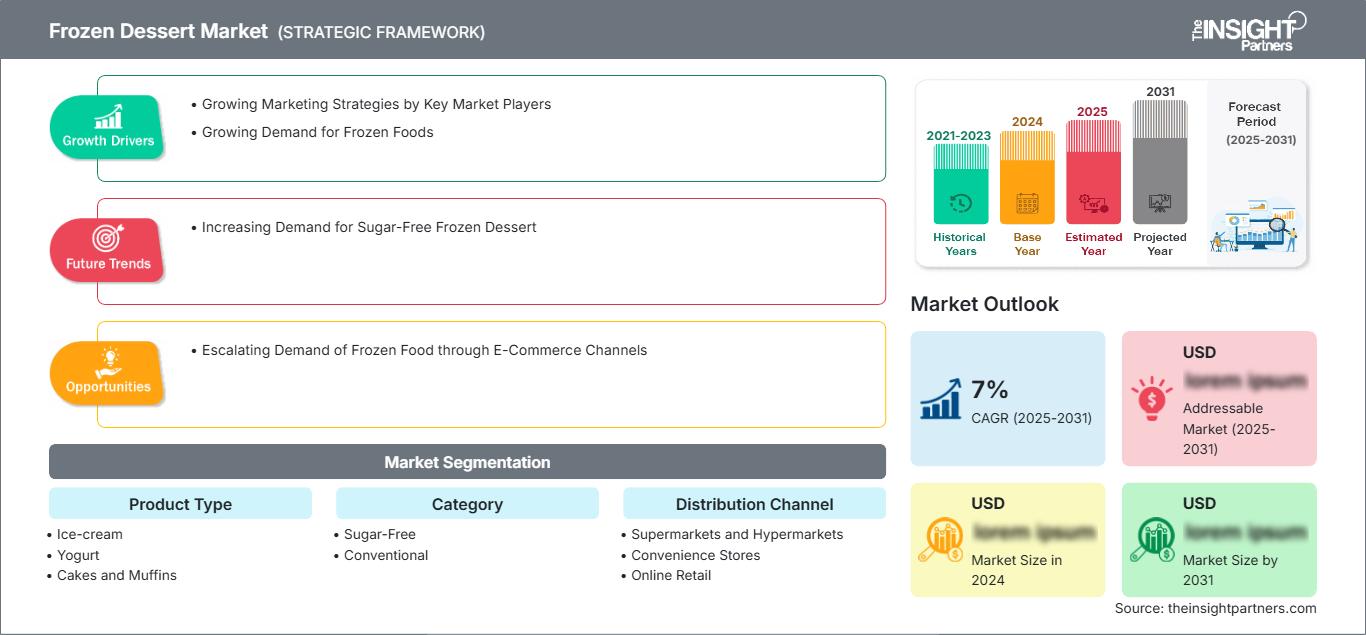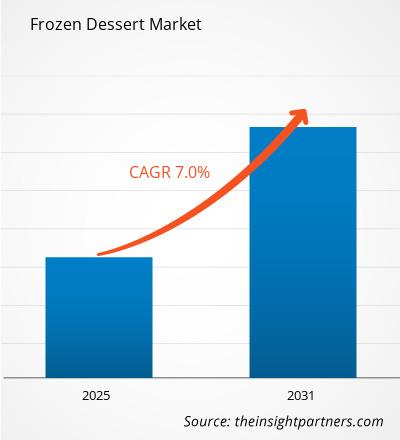냉동 디저트 시장은 2023년부터 2031년까지 연평균 7% 성장할 것으로 예상됩니다. 제품 혁신과 전략적 계획의 확대로 냉동 디저트 시장은 성장하고 있습니다.
냉동 디저트 시장 분석
- 냉동 디저트 제조업체들은 타겟 고객층을 충족하고 증가하는 소비자 수요를 충족하기 위해 제품 혁신에 상당한 투자를 하고 있습니다. 제품 혁신은 기업들이 해외 시장에서 사업 영역을 확대하고 경쟁사보다 우위를 점하는 데 도움이 됩니다.
- 건강에 도움이 되는 냉동 디저트가 소비자들 사이에서 점점 더 인기를 얻고 있습니다. 지난 몇 년 동안 소비자들은 영양 요구르트와 지질, 비타민 및 기타 영양소가 풍부한 소위 유제품이 없는 버전과 같은 건강상의 이점을 주장하며 냉동 디저트에 기꺼이 돈을 쓰고 있습니다.
- 전 세계적으로 냉동 디저트 시장은 번창하는 추세이며, 이는 소비자 선호도 변화, 가처분 소득 증가, 다양한 냉동 디저트의 도입과 같은 여러 요인에 기인합니다.
냉동 디저트 시장 개요
- 냉동 디저트는 액체, 반고체 및 고체 재료를 동결시키는 공정으로 만든 디저트입니다. 아이스크림, 프로즌 요거트, 젤라토, 셔벗, 커스터드, 유제품이 아닌 제품 등 다양한 종류, 질감, 농도, 맛이 있어 소비자에게 선택의 폭이 넓습니다.
- 가처분 소득 증가, 소비자 선호도 변화, 신제품 출시, 저당 및 저칼로리 디저트에 대한 수요 급증 등의 요인이 프로즌 디저트 시장을 활성화하고 있습니다.
- 건강과 웰빙에 대한 관심으로 인해 새로운 맛과 다양한 건강 디저트가 탄생했습니다.
요구 사항에 맞게 이 보고서를 사용자 정의하십시오.
이 보고서의 일부, 국가 수준 분석, Excel 데이터 팩을 포함하여 모든 보고서에 대한 사용자 정의를 무료로 받을 수 있을 뿐만 아니라 스타트업 및 대학을 위한 훌륭한 제안 및 할인을 이용할 수 있습니다
냉동 디저트 시장: 전략적 통찰력

- 이 보고서의 주요 주요 시장 동향을 확인하세요.이 무료 샘플에는 시장 동향부터 추정 및 예측에 이르기까지 데이터 분석이 포함됩니다.
이 보고서의 일부, 국가 수준 분석, Excel 데이터 팩을 포함하여 모든 보고서에 대한 사용자 정의를 무료로 받을 수 있을 뿐만 아니라 스타트업 및 대학을 위한 훌륭한 제안 및 할인을 이용할 수 있습니다
냉동 디저트 시장: 전략적 통찰력

- 이 보고서의 주요 주요 시장 동향을 확인하세요.이 무료 샘플에는 시장 동향부터 추정 및 예측에 이르기까지 데이터 분석이 포함됩니다.
냉동 디저트 시장 성장 동력 및 기회
주요 시장 참여자들의 시장 활성화를 위한 마케팅 전략 확대
냉동 디저트 시장의 성장은 디지털 마케팅과 인플루언서 프로모션에 기인합니다. 이를 통해 기업은 도달 범위를 확장하고 소비자와의 상호작용 및 참여를 개선할 수 있습니다. 타겟 마케팅 및 고객 유지 캠페인 담당자들은 일반적으로 디지털화를 활용하여 제품을 홍보하고 잠재 고객에게 개인화되고 적합한 제품을 추천합니다. 소비자는 충동적인 구매 특성으로 인해 갈망과 즉각적인 욕구에 따라 냉동 디저트를 구매하는 경향이 있습니다. 소비자는 슈퍼마켓, 편의점, 온라인 플랫폼 등 여러 소매점을 통해 냉동 디저트를 구매하는 경우가 많습니다.
온라인 플랫폼을 통한 냉동 디저트 판매 확대로 시장 활성화
전자상거래의 등장은 사람들이 식품을 쇼핑하고 구매하는 방식에 상당한 변화를 가져왔습니다. 소비자들은 냉동식품 구매 시 온라인 소매 플랫폼을 선호합니다. 코로나19 사태로 전 세계 편의점과 식료품점이 문을 닫으면서 식음료의 온라인 판매가 크게 증가했습니다. 미국 냉동식품연구소(American Frozen Food Institute)에 따르면 2021년 냉동식품 온라인 판매가 75% 증가했습니다. 따라서 전자상거래 플랫폼을 통한 냉동 디저트 판매 증가는 냉동 디저트 시장에서 수익성 있는 기회를 창출할 것으로 예상됩니다.
냉동 디저트 시장 세분화 분석
냉동 디저트 시장 분석 도출에 기여한 주요 세그먼트는 제품 유형, 카테고리 및 유통 채널입니다.
- 제품 유형에 따라 시장은 아이스크림, 요구르트, 케이크 및 머핀, 기타로 세분화됩니다.
- 카테고리에 따라 냉동 디저트 시장은 무설탕과 일반으로 나뉩니다.
- 유통 채널을 기준으로 시장은 슈퍼마켓 및 하이퍼마켓, 편의점, 온라인 소매점 및 기타로 나뉩니다.
지역별 냉동 디저트 시장 점유율 분석
- 냉동 디저트 시장 보고서는 북미, 유럽, 아시아 태평양, 중동 및 아프리카, 중남미를 포함한 5개 주요 지역에 대한 상세 분석으로 구성되어 있으며, 현재 및 과거 시장 규모와 2021년부터 2031년까지의 전망을 포함합니다.
- 각 지역은 국가별로 세분화됩니다. 이 보고서는 18개 이상 국가에 대한 분석 및 전망을 제공하며, 지역 수준에서 시장에 영향을 미치는 동인, 트렌드, 기회 등 냉동 디저트 시장 역학을 다룹니다.
- 또한 이 보고서는 해당 지역의 냉동 디저트 시장에 영향을 미치는 주요 요인을 분석하는 포터의 5가지 힘 분석(Five Forces Analysis)도 다룹니다.
냉동 디저트 시장
냉동 디저트 시장
The Insight Partners의 분석가들은 예측 기간 동안 냉동 디저트 시장에 영향을 미치는 지역별 동향과 요인을 면밀히 분석했습니다. 이 섹션에서는 북미, 유럽, 아시아 태평양, 중동 및 아프리카, 그리고 중남미 지역의 냉동 디저트 시장 세분화 및 지역별 분포도 살펴봅니다.
냉동 디저트 시장 보고서 범위
| 보고서 속성 | 세부 |
|---|---|
| 시장 규모 2024 | US$ XX million |
| 시장규모별 2031 | US$ XX Million |
| 글로벌 CAGR (2025 - 2031) | 7% |
| 이전 데이터 | 2021-2023 |
| 예측 기간 | 2025-2031 |
| 다루는 세그먼트 |
By 제품 유형
|
| 포함된 지역 및 국가 | 북미
|
| 시장 선도 기업 및 주요 회사 프로필 |
|
냉동 디저트 시장 참여자 밀도: 비즈니스 역학에 미치는 영향 이해
냉동 디저트 시장은 소비자 선호도 변화, 기술 발전, 그리고 제품의 효능에 대한 인식 제고 등의 요인으로 인한 최종 사용자 수요 증가에 힘입어 빠르게 성장하고 있습니다. 수요가 증가함에 따라 기업들은 제품 라인업을 확장하고, 소비자 니즈를 충족하기 위한 혁신을 추진하며, 새로운 트렌드를 적극 활용하고 있으며, 이는 시장 성장을 더욱 가속화하고 있습니다.

- 을 얻으세요 냉동 디저트 시장 주요 주요 플레이어 개요
냉동 디저트 시장 뉴스 및 최근 동향
냉동 디저트 시장은 1차 및 2차 조사 후 주요 기업 간행물, 협회 데이터, 데이터베이스 등 정성적 및 정량적 데이터를 수집하여 평가합니다. 냉동 디저트 시장의 몇 가지 동향은 다음과 같습니다.
- 유니레버, 2022년 신제품 냉동 간식 19종 출시. (출처: 유니레버/보도자료/2022년 1월)
- 오틀리, 스틱형 냉동 오틀리 신제품 출시. 오틀리 그룹 AB는 최신 제품 혁신 제품인 오틀리 무유 냉동 디저트 바 출시를 발표했습니다. (출처: 오틀리/보도자료/2021년 11월)
- 시트라팩, 냉동 요거트 디저트 라인 출시. 시트라팩은 네이처스 프리미엄(Nature's Premium) 브랜드로 새로운 냉동 요거트 디저트 제품 라인을 추가했습니다. (출처: CitraPac/보도자료/2024년 4월)
냉동 디저트 시장 보고서 범위 및 성과물
“냉동 디저트 시장 규모 및 예측(2021~2031년)” 다음 영역을 포괄하는 시장에 대한 자세한 분석을 제공합니다.
- 범위에 포함된 모든 주요 시장 부문에 대한 글로벌, 지역 및 국가 수준의 냉동 디저트 시장 규모 및 예측
- 냉동 디저트 시장 동향 및 추진 요인, 제약 및 주요 기회와 같은 시장 역학
- 포터의 5가지 힘 및 SWOT 분석에 대한 자세한 분석
- 주요 시장 동향, 글로벌 및 지역 프레임워크, 주요 업체, 규정 및 최근 시장 동향을 포괄하는 냉동 디저트 시장 분석
- 시장 집중도, 히트맵 분석, 주요 업체 및 냉동 디저트 시장의 최근 동향을 포괄하는 산업 환경 및 경쟁 분석
- 자세한 회사 프로필
- 과거 분석(2년), 기준 연도, CAGR을 포함한 예측(7년)
- PEST 및 SWOT 분석
- 시장 규모 가치/거래량 - 글로벌, 지역, 국가
- 산업 및 경쟁 환경
- Excel 데이터세트
최근 보고서
관련 보고서
사용 후기
구매 이유
- 정보에 기반한 의사 결정
- 시장 역학 이해
- 경쟁 분석
- 고객 인사이트
- 시장 예측
- 위험 완화
- 전략 기획
- 투자 타당성 분석
- 신흥 시장 파악
- 마케팅 전략 강화
- 운영 효율성 향상
- 규제 동향에 발맞춰 대응






















 무료 샘플 받기 - 냉동 디저트 시장
무료 샘플 받기 - 냉동 디저트 시장